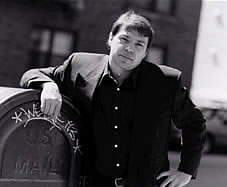I was inspired to write Black and White, a novel about two Long Island City High School basketball stars and best friends who thought they'd "put all that racial crap behind us till we were almost like real blood-brothers," by several very real experiences in New York City.
From 1992-1998, I taught adolescents awaiting trial on Rikers Island to read and write. The job was incredibly rewarding, and eye opening. Unfortunately, one of the most striking elements on Rikers Island is race. The inequities of the criminal justice system, including who can afford the best lawyer and who can make bail, has deemed that an overwhelming majority of inmates there are African-American.
The protagonists in Black and White, Marcus Brown (Black) and Eddie Russo (White), come in contact with that system when they put their sure-shot college scholarships at risk by staging a series of stickups to afford trendy new basketball kicks. But once they get caught, their storybook friendship faces a new kind of reality.
Marcus- "That whole first night, I kept thinking how if Eddie got arrested with me, his family would have bailed him out. Only I'd still be there. I couldn't beef about it. It wouldn't have been Eddie's fault. That's the way it is. We could be Black and White anywhere else in the world. But not on Rikers Island."
Prior to teaching on Rikers, I was helping to coach a NYC high school basketball team, when we arrived at Long Island City High School for a road game. A gym class was still going on, so we waited at a side door. Some players from the LIC squad came down and took our team up the back stairs to the visitor's locker room. One of those kids played a super game against us, and caught my eye. Only the next time I saw him, it was on the six o'clock news. LIC had gone upstate to play in a tournament. There was a lot of racial taunting coming out of the stands. Then suddenly, the whole gym went zoo. In the white spotlight on the news video, I could see that young man getting stabbed through the back with a chair leg, and dying right there on the court.
That tragic death is the reason the novel is set at LIC, and its surrounding neighborhood. In the book, both Marcus and Eddie knew and looked up to that young man, who was several years ahead of them in school and on the team. The circumstance of his death provides the pair with a reference point for their own friendship.
Marcus on the stabbing- "People around my way said it was because of that natural hatred. That line between blacks and whites that can't get erased, no matter what. I just remember hating that kid's guts because of what he did. Not because he was white. And everybody I knew- no matter what color- hated him, too."
Just a few years ago, I was riding the "G" Train in Brooklyn when an intoxicated, homeless man with feces stained pants went on a racially driven tirade, baiting whites, African-Americans and Jews to fight each other. The passengers in that train car took everything he had to say, and probably learned something about how much heat they could take without letting someone bring them to the boiling point.
I put Marcus and Eddie on that train with their teammates to hear what that man had to spew. Their teammates find it hilarious, but the protagonists don't.
Eddie- "Other kids were howling. But not us. Maybe a month ago, we'd have been laughing too."
Why the change? Marcus knows he has to accept a plea and go to prison soon, while Eddie, who's just as guilty, is heading off to St. John's on a basketball scholarship. Can they still remain tight with the different hands they've been dealt?
Eddie- "After Marcus left, I wondered how it would feel to be free of this whole thing, or at least tell everyone the truth. I stood on the corner of my block and looked out into the traffic. Then I pulled up everything I'd been thinking about and feeling. I opened my mouth wide to scream. But not a sound came out."
As for me, I'm satisfied that I can channel what I've experienced and what I feel into books for young adults.
|

